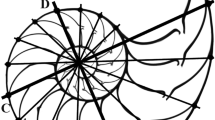Summary
The spinning apparatus ofLinyphia triangularis, adult females and males, was studied with the scanning electron microscope and the main anatomical and histochemical characteristics of the silk glands, including the epigastric apparatus of males, are presented. The epigastric glands seem to be important for the construction of sperm webs. A detailed account of the use of the different kinds of silk in web building is given.
The spinning apparatus ofLinyphia closely corresponds to the araneid pattern. Characteristic of linyphiid spiders is the poor development of the aciniform glands. Corresponding to the minor importance of capture threads forLinyphia, the triads (aggregate and flagelliform glands) are less developed than in Araneidae.Linyphia make much less use of the secretions of the piriform glands for connecting threads than Araneidae. Capture threads adhere to other threads by their own glue; other threads seem mostly to be bound to one another by the secretion of the minor ampullate glands whose chemical properties, inLinyphia, appear especially adapted to this function. Neither the anatomical and histochemical data concerning the spinning apparatus nor the structure of the webs provide any indication of close relationships between Linyphiidae and Agelenidae, as was recently claimed.
Similar content being viewed by others
References
Apstein C (1889) Bau und Funktion der Spinndrüsen der Araneida. Arch Naturgesch 55:29–74
Blanke R (1975) Das Sexualverhalten der GattungCyrtophora als Hilfsmittel für phylogenetische Aussagen. Proc 6th Int Arachn Congr 1974:116–119
Bristowe WS (1958) The world of spiders. Collins, London
Coddington JA (1989) Spinneret silk spigot morphology, evidence for the monophyly of orb weaving spiders. Cyrtophorinae (Araneidae) and the group of Theridiidae and Nesticidae. J Arachnol 17: 71–95
Denny M (1976) The physical properties of spider's silk and their role in the design of orb-webs. J Exp Biol 65:347–361
Hopfmann S (1935) Bau und Leistung des Spinnapparates einiger Netzspinnen. Jena Z Naturwiss 70:65–111
Kaston BJ (1964) The evolution of spider webs. Am Zool 4:191–237
Kovoor J (1976) Caractères adaptatifs et caractères familiaux des glands séricigènes dans le genreHippasa E. Simon (Araneae, Lycosidae). C R 3e Coll Arachn Expr fr, Les Eyzies, pp 83–96
Kovoor J (1977) La soie et les glandes séricigènes des Arachnides. Année Biol 16:97–171
Kovoor J (1987) Comparative structure and histochemistry of silk-producing organs in arachnids. In: Nentwig W (ed) Ecophysiology of spiders. Springer, Heidelberg, pp 160–186
Kovoor J, Lopez A (1982) Anatomie et histologie des glandes séricigènes desCyrtophora (Araneae, Araneidae): affinités et corrélations avec la structure et la composition de la toile. Rev Arachnol 4:1–21
Kovoor J, Lopez A (1988) L'appareil séricigène desMecynogea Simon (Araneae, Araneidae). Rev Arachnol 7:205–212
Kovoor J, Peters HM (1988) The spinning apparatus ofPolenecia producta (Araneae, Uloboridae): Structure and histochemistry. Zoomorphology 108:47–59
Kullmann E (1958) Beobachtung des Netzbaues and Beiträge zur Biologie vonCyrtophora citricola Forskal (Araneae, Araneidae) (Zugleich ein Beitrag zur Phylogenie der Radnetzspinnen). Zool Jb Syst 86:181–216
Kullmann R (1971) Bemerkenswerte Konvergenzen im Verhalten cribellater und ecribellater Spinnen. Freunde Kölner Zoo 13 (1970/71): 123–150
Lopez A, Emerit M (1988) New data on the epigastric apparatus of male spiders. Bull Br Arachnol Soc 7:220–224
Marples BJ (1949) An unusual type of web constructed by a Samoan spider of the family Argiopidae. N Z Science Congr 1947:232–233
Millidge AF (1988) The relatives of the Linyphiidae: phylogenetic problems at the family level (Araneae). Bull Br Arachnol Soc 7:253–268
Nielsen E (1932) The biology of spiders. With special reference to the Danish fauna. Levin Munksgaard, Copenhagen
Peters HM (1982) Wie Spinnen der Familie Uloboridae ihre Beute einspinnen und verzehren. Verh Naturwiss Ver, Hamburg (NF) 25:147–167
Peters HM (1987) Fine structure and function of capture threads. In: Nentwig W (ed) Ecophysiology of spiders. Springer, Heidelberg, pp 187–202
Peters HM (1990) On the structure and glandular origin of bridging lines used by spiders for moving to distant places. Acta Zool Fenn 190:309–314
Peters HM, Kovoor J (1980) Un complément à l'appareil séricigène des Uloboridae: le paracribellum et ses glandes. Zoomorphology 96:91–102
Schlott M (1931) Biologische Studien anAgelena labyrinthica. Z Morphol Ökol Tiere 24:1–77
Vollrath F, Edmonds DT (1989) Modulation of the mechanical properties of spider silk by coating with water. Nature 340 (6231):305–307
Wasowska S (1966) Comparative morphology of the spinning fields in females of some spider species. Zool Pol 16:9–30
Wiehle H (1928) Beiträge zur Biologie der Araneen, insbesondere zur Kenntnis des Radnetzbaues. Z Morphol Ökol Tiere 11:115–151
Wiehle H (1956) Spinnentiere oder Arachnoidea (Araneae). 28. Familie Linyphiidae-Baldachinspinnen. In: Dahl M, Bischoff H (eds) Die Tierwelt Deutschlands. 44. Teil Fischer, Jena, pp 1–337
Author information
Authors and Affiliations
Rights and permissions
About this article
Cite this article
Peters, H.M., Kovoor, J. The silk-producing system ofLinyphia triangularis (Araneae, Linyphiidae) and some comparisons with Araneidae. Zoomorphology 111, 1–17 (1991). https://doi.org/10.1007/BF01632706
Issue Date:
DOI: https://doi.org/10.1007/BF01632706




